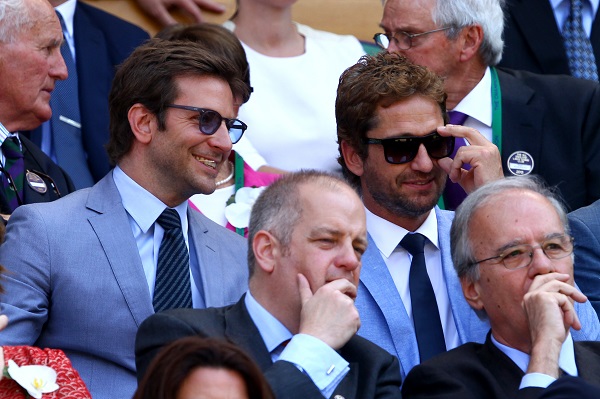The first Briton in 77 years won the Wimbledon championships on Sunday, but this is perhaps incidental; did you spot the real thing of note? That Bradley Cooper and Gerard Butler were there to watch him, and were actually laughing and talking to each other, like normal human beings? That’s the real story here!
From the flurry of online activity about the sighting of the pair, you might be forgiven for thinking they had done something other than, well, just stand there watching the tennis and have a friendly chat, as all the other spectators (or those who weren’t instead scanning the crowd for well-known faces) were doing.
Celeb-spotting at Wimbledon has long been considered something of a sport, but do we really find it as fascinating as the spectacle we have either paid, or tuned in, to see? The one that the celebrities (whom we are watching), are themselves watching?
It would appear so, and the custom has been put to good use. Reading about actors in gossip columns is a common habit that has been harnessed by Hollywood PR campaigns. These may ‘leak’ information about problems encountered on set or during the production process and relationships that may have formed. Stunts may be pulled in the full-knowledge that they will then be written about and will garner more hype, which may contribute to the initial success of a film.
Such media campaigns are successful because they feed the public what they already hunger for and as a result, film criticism must also engage with such trivia, up to a point. Mark Kermode’s tweet about Butler during the tennis on Sunday serves as a case in point:
This Gerard Butler film on television at the moment is a lot more exciting than most of his movies …
— Mark Kermode (@KermodeMovie) July 7, 2013
Whether or not the critic might find such media-nuggets note-worthy, he must (for the most part) appeal to the typical reader and film-viewer; just as the director and producer might be pressured by commercial backers to direct their efforts firmly towards the average viewer: the widest audience available to buy tickets and ultimately fund a film. The critic often mediates the gap between director and viewer and, producers hope, will continue the process that they have set in motion: translating the characteristics of a film into the written word, passing it on to potential viewers and colluding in any PR or media-hype surrounding its release.
And so it is the general public who will often dictate (albeit unconsciously) the direction that films and criticism take, and this has long been a key part of much writing about film. Gilbert Adair’s comprehensive book on film, Night At The Pictures, is often cited as a pivotal work. Primarily, it describes seminal motion-pictures and relays details about the actors and directors involved in the making of them; it is used mainly as an inventory for central works over the ages and the figures that made them possible – almost like a selective encyclopaedia for the reader to flick through. Salman Rushdie’s The Wizard of Oz, in contrast, is a sort of love letter to the film of the same name. An explanation of how it inspired him and played a part in making him the novelist he is today, it also details anecdotes about the experiences that the actors had on set (such as the bullying of the actress that played The Wicked Witch of the West), noting our curiosity about such incidents and questioning whether or not it actually sullies our experience of the film.
Do we really want to know such things? Well, the very fact that books like these are published and available tells us that there is a market for them and that we enjoy reading about film – analysis as well as divulged snippets of gossip. And we enjoy it, because it is all part of the cinematic experience. Film erects a veil of unreality and escapism. We are aware of its illusion, but we still demand to be let in on as many of its secrets as we possibly can; we want the whole experience to be exposed to us so that we may pore over it in all its detail. This acts as a further distraction and form of entertainment in its own right.
Photographs of celebrities – snapshots, like stills from a film – combine with stories and text about their private lives to create something like a film themselves; a narrative that members of the public can follow. The exploits of famous individuals might be so far removed from the lives of the vast majority who follow them that readers of such material could ostensibly still be watching a constructed story acted out on screen – with the added thrill that these exploits are, supposedly, real.
And so, unless we stop caring quite so much about our celebrities (and scientific behavioural studies into human hero/alpha-worship suggest that it is actually quite deeply ingrained in our psyche) we will continue to see almost as much column space (slight exaggeration as this may be) dedicated to the news of two men standing and joking around in a crowd as we will to a feat of athletic prowess that few of us could emulate. But, as Clint Eastwood once said, ‘c’est la vie’.






Comments